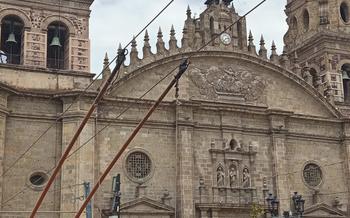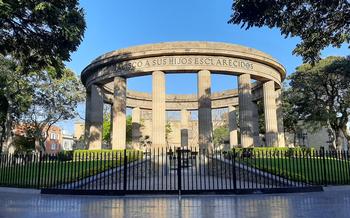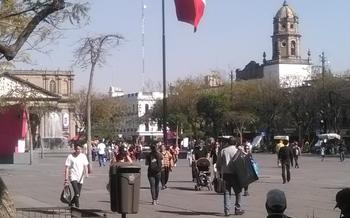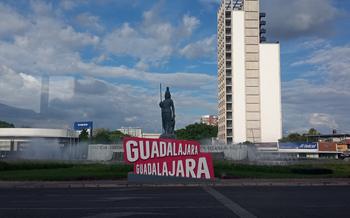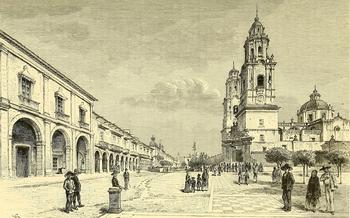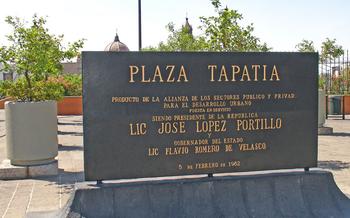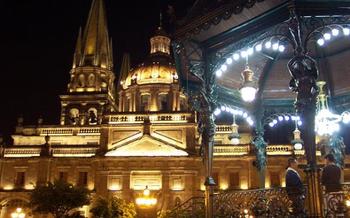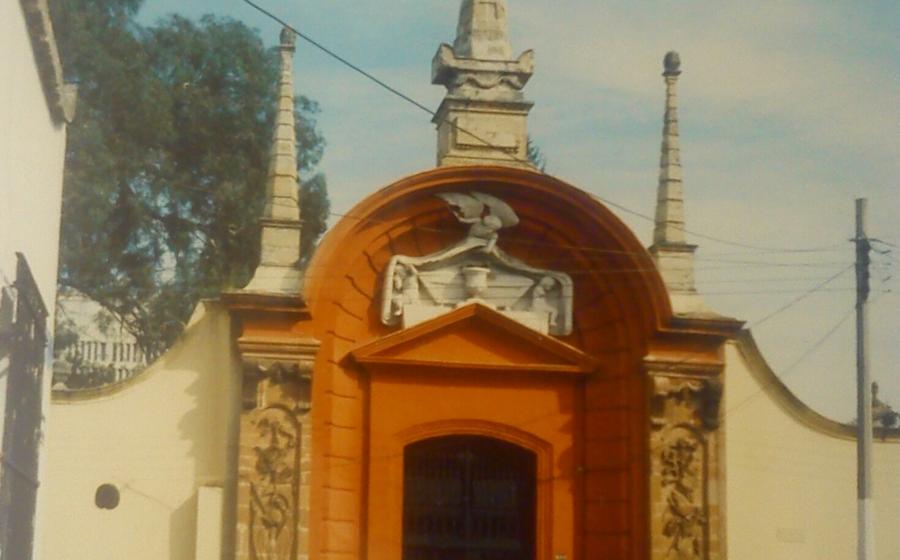
Panteón de Belén
- A City of History and Culture
- Panteón de Belén: An Iconic Landmark
- Exploring the Cemetery
- Famous Residents of the Panteón de Belén
- The Legend of the Weeping Woman
- Visiting the Panteón
- Safety Considerations
- The Panteón de Belén in Popular Culture
- Local Cuisine and Experiences
- Insider Tip: Hidden Gems
A City of History and Culture
Guadalajara, the capital of the Mexican state of Jalisco, is a city steeped in history and culture. Founded in 1542 by Spanish conquistadors, Guadalajara played a pivotal role in Mexico's struggle for independence and served as the country's capital on several occasions Guadalajara is also renowned for its vibrant cultural scene, with a thriving art community, numerous museums, and a diverse culinary landscape that showcases traditional Mexican cuisine. The city's vibrant energy and cultural attractions make it a captivating destination for travelers seeking a glimpse into Mexico's rich past and dynamic present.
Panteón de Belén: An Iconic Landmark
The Panteón de Belén, of time. Established in 1848, it was the first officially designated cemetery in the city and quickly became the final resting place for many of Guadalajara's most prominent citizens.
The cemetery's origins can be traced back to the mid-19th century when the city's growing population necessitated the creation of a new cemetery. The site chosen was a former orchard located on the outskirts of the city, which at the time was considered a fitting location for a place of eternal rest.
Over the years, the Panteón de Belén has become a symbol of Guadalajara's rich history and culture. Its elaborate tombs and mausoleums, adorned with intricate carvings and sculptures, reflect the city's architectural heritage and artistic traditions. The cemetery is also a significant cultural landmark, as it is the burial place of many notable figures who have made significant contributions to Mexican history and culture.
Exploring the Cemetery
The Panteón de Belén is an architectural marvel, designed with intricate details and symbolism. The layout of the cemetery is symmetrical, with central pathways intersecting at right angles, creating a grid-like pattern. This design allows for easy navigation and provides a sense of order and harmony.
Notable tombs and mausoleums are scattered throughout the cemetery, each with its own unique design and story to tell. Some of the most impressive tombs include the neo-Gothic chapel of the Degollado family, the Art Nouveau mausoleum of the Cuéllar family, and the elaborate tomb of the Camarena family, which features a life-sized bronze sculpture of a grieving woman.
The Panteón de Belén showcases a variety of artistic and architectural styles, reflecting the diverse cultural influences that have shaped Guadalajara's history. Neoclassical, Gothic, Art Nouveau, and Art Deco are just a few of the styles represented in the cemetery's tombs and mausoleums. This eclectic mix of styles creates a visually captivating landscape that is both beautiful and thought-provoking.
Famous Residents of the Panteón de Belén
The Panteón de Belén is the final resting place of numerous prominent figures from Mexican history and culture. Among the of 185
-
Luis Barragán: A celebrated architect known for his unique blend of Mexican and modernist styles. His iconic works include the Cuadra San Cristóbal House and the Torres de Satélite.
-
José Clemente Orozco: One of Mexico's most influential muralists, known for his powerful and socially conscious works. His murals can be seen in the Palacio de Bellas Artes in Mexico City and the Guadalajara Cathedral.
-
Juan Rulfo: A renowned writer and one of the pioneers of the Latin American Boom. His masterpiece, "Pedro Páramo," is considered one of the greatest works of Mexican literature.
These individuals, along with many others, have left an indelible mark on Mexican history and culture, and their presence in the Panteón de Belén serves as a testament to the rich heritage of Guadalajara and Mexico.
Anecdotes and stories:
-
The tomb of Ignacio L. Vallarta is said to have been designed by himself, reflecting his passion for mathematics and astronomy.
-
José Clemente Orozco's remains were moved to the Panteón de Belén in 1985, after having been buried in Mexico City.
-
Juan Rulfo's grave is often visited by literary enthusiasts who pay homage to the great writer.
The Legend of the Weeping Woman
The Panteón de Belén is inextricably linked to the haunting legend of La Llorona, the Weeping Woman. Originating from pre-Hispanic mythology, this tragic tale tells of a woman who drowned her children in a fit of rage and was condemned to wander the earth for eternity, weeping for her lost loved ones. Over time, the legend has become deeply embedded in Mexican culture and folklore, taking on various forms and interpretations. In Guadalajara, the Panteón de Belén is often associated with the Weeping Woman's presence, as it is believed that she roams the cemetery at night, searching for her lost children. This eerie connection has added an air of mystery and intrigue to the cemetery, attracting visitors who come to experience the thrill of encountering the supernatural.
Visiting the Panteón
The Panteón de Belén is open to the public free of charge. Guided tours are available for a small fee and can be booked in advance or arranged upon arrival. The tours provide a fascinating insight into the history and significance of the cemetery, as well as the stories behind some of its most famous residents.
Visitors are advised to dress respectfully and be mindful of the cemetery's sacred nature. Photography is permitted, but visitors should be respectful of the privacy of others and avoid disturbing the peace. The cemetery is a popular spot for locals and tourists alike, so it is best to visit during the week or early in the morning to avoid the crowds.
Safety Considerations
The Panteón de Belén, like any public space, requires visitors to take certain precautions to ensure their safety. Here are some essential tips to keep in mind:
-
Be aware of your surroundings: As with any unfamiliar place, it's important to remain vigilant and pay attention to your surroundings. Be mindful of individuals who may approach you with unsolicited services or goods.
-
Avoid visiting at night: While the Panteón de Belén is open to visitors during daylight hours, it's generally not advisable to visit at night. The cemetery's secluded nature and lack of lighting can make it a potential safety hazard.
-
Respect local customs: Remember that the Panteón de Belén is a sacred space for many Mexicans. Be respectful of the mourners and visitors who may be visiting the graves of their loved ones. Avoid loud conversations, disruptive behavior, or any actions that may show disrespect.
-
Stay on designated paths: The Panteón de Belén has designated paths and walkways for visitors to follow. Stay on these paths to avoid disturbing the graves and vegetation.
-
Be cautious of valuables: As with any public place, it's important to be mindful of your belongings. Avoid carrying large amounts of cash or displaying expensive jewelry.
By following these safety tips, you can ensure a safe and enjoyable visit to the Panteón de Belén.
The Panteón de Belén in Popular Culture
The Panteón de Belén has been immortalized in popular culture, becoming a source of inspiration for artists, writers, and filmmakers. Its unique atmosphere and intriguing stories have captured the imagination of creators, leading to its representation in various forms of media.
In literature, the cemetery has been featured in novels, short stories, and poems. Notable works include "The Shadow of the Wind" by Carlos Ruiz Zafón, which delves into the mystery surrounding a secret society operating within the Panteón de Belén.
On the big screen, the cemetery has served as a backdrop for several Mexican films. One of the most famous examples is "Macario" (1960), which tells the story of a poor woodcutter who makes a pact with the devil in the Panteón de Belén.
The Panteón de Belén has also found its way into music, with several songs referencing the cemetery or its legends. One of the most well-known songs is "La Llorona" ("The Weeping Woman"), a traditional Mexican folk song that has been recorded by numerous artists.
These cultural representations have played a crucial role in popularizing the Panteón de Belén and attracting visitors from around the world. They have helped to cement the cemetery's status as an iconic landmark and a symbol of Mexican history and culture.
Local Cuisine and Experiences
Gastronomic Delights of Guadalajara
Guadalajara, the vibrant capital of Jalisco, is renowned for its rich culinary heritage. While exploring the city's many attractions, be sure to savor the mouthwatering local cuisine that has made this region famous. From traditional street food to upscale dining experiences, Guadalajara offers a culinary adventure for every palate.
Tantalizing Street Food
For an authentic taste of Guadalajara, dive into the world of street food. Sample the city's iconic dish, tortas ahogadas, a delicious sandwich of carnitas drowned in a spicy tomato sauce. Try the birria, a slow-cooked goat stew served with tortillas and consommé, or indulge in the greasy but irresistible tacos al pastor, made with spit-roasted pork and pineapple.
Upscale Dining Experiences
For a more refined dining experience, Guadalajara offers a range of upscale restaurants that showcase the region's culinary creativity. Enjoy a multi-course meal at one of the city's top-rated restaurants, such as La Leche, known for its innovative takes on Mexican classics. Or savor the flavors of Jalisco at Casa Bariachi, a charming restaurant set in a historic building, where you can enjoy traditional dishes with a modern twist.
Cultural Experiences to Enhance Your Visit
To fully immerse yourself in the culture of Guadalajara, take advantage of the many cultural experiences the city has to offer. Visit the Instituto Cultural Cabañas, a UNESCO World Heritage Site, to admire its stunning murals by renowned Mexican artist José Clemente Orozco. Stroll through the historic center, with its colonial architecture and lively plazas, and soak up the vibrant atmosphere. Or take a day trip to nearby Tequila, the birthplace of the world-famous spirit, where you can visit distilleries and sample different types of tequila.
Unforgettable Culinary and Cultural Journey
Guadalajara offers a harmonious blend of history, culture, and gastronomy, ensuring an unforgettable journey for visitors. Whether you're indulging in street food, savoring upscale dining experiences, or exploring the city's rich cultural heritage, Guadalajara promises a feast for the senses that will leave you craving for more.
Insider Tip: Hidden Gems
Beyond the famous landmarks and popular attractions, the Panteón de Belén holds many hidden gems waiting to be discovered by curious explorers. Venture off the beaten path to uncover lesser-known areas of the cemetery, where you'll find hidden tombs, forgotten stories, and intriguing secrets.
Look for the unmarked graves, often tucked away in corners or behind overgrown vegetation. These final resting places may belong to individuals whose names have faded from memory but whose stories deserve to be remembered.
Pay attention to the intricate details and symbolism on the tombstones. Many of these markers feature unique carvings, inscriptions, and iconography that provide clues to the lives and legacies of the deceased.
Explore the surrounding neighborhoods to gain a deeper understanding of the context and culture that shaped the Panteón de Belén. Visit the nearby Mercado de San Juan de Dios, a bustling market where you can find traditional Mexican crafts, souvenirs, and delicious local cuisine.
Stroll along the picturesque streets of the Centro Histórico, where you'll encounter historic buildings, charming plazas, and vibrant street life. Immerse yourself in the rich history and culture of Guadalajara, and discover the hidden treasures that await in every corner of this fascinating city.
